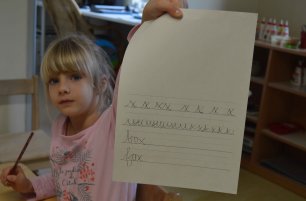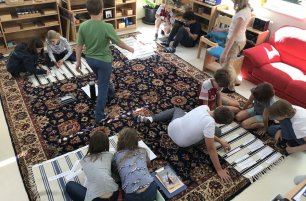The Benefits of Cursive Handwriting
It can be an exciting time when your child begins to read and write their first words. They are at the dawn of an exhilarating literacy journey that will open their eyes to a world of books, knowledge, and wonder!
However, with present technological advances happening at record speed – many parents may ponder over the importance of cursive handwriting in today’s climate – since few people still write with pen and paper, let alone in cursive script. Nonetheless, researchers believe that aside from cursive script having great aesthetic value, there are also numerous mental, physical, social, and practical benefits.

Let’s take our own journey to explore the many other rewards reaped by children who embark on developing their own uniquely attractive, legible cursive handwriting style:
Improved neural connections
Forming letters with the hand by using pen or pencil is cognitively different than pushing a physical or virtual key on a keyboard. Writing strengthens the dynamic interplay between the left and right hemispheres of the brain and helps build neural pathways. When learning, forming letters by hand creates a connection with the movement of the hand to the visual response of seeing the letter on the page. There are multiple processes coexisting simultaneously: the movement of the hand, the thought of the letter, and the visual cue of the letter - this is reading and writing concurrently, which is a necessary skill that supports children’s future success regarding their reading and writing skills. It is important for children to go through this process to fully understand the English language and connect words to their motor memory.
Improved fine motor skills
When learning cursive and actively using it, children also learn how to position their paper and their pencil on the paper. Likewise, they are also learning how much force is needed on their paper to form legible words and sentences. Moreover, through use of cursive writing children learn to properly form sentences from left to right on paper, as well as gaining a deeper understanding of sentence structure and word spacing. Cursive script also helps to improve hand-eye coordination because of the unique writing style, between the connection of letters and consistency between words and sentences when writing in cursive.
Increased attention span whilst writing
There is a correlation between handwriting speed and attention span during writing as it supports the active use of children learning cursive script, as opposed to using print. Children using print will naturally write slower due to the stop and start strokes of printed letters. Therefore, due to the connectivity of a simple cursive style, children can write faster – in turn this increases their continuity and fluidity in writing, which encourages greater amounts of writing.
Helps with grammar, spelling, and overall understanding
Writing words on paper supports children’s ability to recognise words when they read them later. It requires children to write from left to right so that letters will join in the proper sequence and with proper spacing. Furthermore, it aids spelling through muscle memory, as the hand acquires memory of spelling patterns children repeatedly use through the fluid movements of cursive style. As it turns out, this is the same phenomenon that occurs when pianists learn patterns of hand movements through continued repetition to make music! On the contrary, typing doesn’t have the same effect on the brain, as it doesn’t require the same fine motor skills and simultaneous activity. Therefore, while children are learning cursive, rewriting each letter and word they are also learning things like letter structure, word structure and sentence structure. A study at Universite de Sherbrooke, in Quebec, Canada, showed that children who learn cursive at a young age are more likely to become better at spelling and writing.

Strengthens internal self-discipline
Cursive handwriting is complex, as well as being inherently connected with the development of children’s fine-motor skills and hand-eye coordination, which as a result requires a level of increased attention and concentration. The discipline required to use cursive script prompts children to also develop self-discipline internally, which I think we can agree is a useful skill in all areas of life.
Promotes self-respect
The ability to master the skill of writing clearly and fluidly improves children’s confidence to communicate freely with the written word. Handwriting is a vital skill for life.
So, while everyone should learn to type in today’s world, cursive handwriting certainly has its benefits and for this reason it remains a crucial skill for children to accomplish while at school. It may take a little perseverance and time to learn, but it supports children’s organization skills, as well as assists them in composing their own thoughts and ideas. What’s more, it was Dr. Montessori who discovered the importance of learning through movement and the senses and present research corroborates the vital hand/brain connection, proving that new pathways in the brain develop as children use their hands to explore and interact with the world. Of course, it shouldn’t have to be an either/or decision: children can be computer literate and learn cursive – so let’s grant our children the best start, as they embark into a world of literature by supporting and cultivating their unique cursive style writing, so to enable them to reap all the wonderful benefits of picking up that pencil and paper!
For more info on the brain benefits of setting our keyboards aside, there is a wonderful article which can be viewed online called ‘Why Writing by Hand Could Make You Smarter’ by William Klemm.
“Children develop their brains as well as their bodies through movement, and in the process of concentration, self-discipline, and perseverance with an active interest, the foundations of character are laid.” Maria Montessori
Are you curious about how Montessori can help your child thrive? Contact us to schedule and individual tour.
LEARN MORE AND CONTACT US TO SCHEDULE A TOUR











